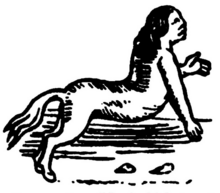This is an old revision of this page, as edited by Rtkat3 (talk | contribs) at 23:36, 12 June 2023 (Doing some rewriting. One description had to match the picture on this page.). The present address (URL) is a permanent link to this revision, which may differ significantly from the current revision.
Revision as of 23:36, 12 June 2023 by Rtkat3 (talk | contribs) (Doing some rewriting. One description had to match the picture on this page.)(diff) ← Previous revision | Latest revision (diff) | Newer revision → (diff)
Ipotanes or hippotaynes are mythical creatures. They are usually depicted as being half-human half-horse creatures much different from the centaurs. Although sometimes attributed to Greek mythology, the term appears to have originated at a much later date, and without a definite description; they are first mentioned in John de Mandeville's fourteenth-century Travels. Ipotanes appear in modern works of the fantasy genre.
John de Mandeville
In his 1356 travelogue, The Travels of Sir John Mandeville, the author reports the existence of a violent race of ipotanes, found in Bacharie (Bactria).
...ben many Ipotanes that dwellen sometime in the water and sometime on the land; and thei ben half men and half hors and thei eten men when thei may take him
— Wyken and Worde, 1499.
More recent editions of Mandeville's work use various spellings; hippotaynes (Macmillan, 1900), hippopotami (Penguin, 1983).
Description
The word "ipotane" appears to be derived from the Greek ιππότης (hippotes), "a knight", which itself is derived from ίππος (hippos), "a horse". Mandeville's description is not clearly distinguishable from that of a centaur, and some depictions use the term synonymously. Some depictions show ipotanes with a human body and a horse's head. Other depictions have them as humans with the hindquarters of a horse.
Modern literature
Despite their similarity to centaurs, ipotanes are not mentioned in the corpus of Greek and Roman literature. However, they appear in modern works of fantasy literature, in which they are depicted with various combinations of horse-like and human features.
See also
References
- Charles Knight, Charles Knight's Popular History of England, vol. 2, p. 13, London: Bradbury, Evans, & Company, 1862–67 OCLC 942643783.
- ^ John Vinycomb, Fictitious & Symbolic Creatures in Art, p. 144, Gale Research Company, 1906 ISBN 0810331470.
- Sir John Mandeville, A.W. Pollard (ed), The Travels Of Sir John Mandeville, p. 177, London: Macmillan & Co., 1900 OCLC 1268064505
- Sir John Mandeville, C.W.R.D. Pollard (trans), The Travels Of Sir John Mandeville, p. 167, Penguin, 1983 OCLC 1261243004.
- Henry George Liddell, Robert Scott, A Greek-English Lexicon, p. 708, Oxford: Clarendon Press, 1890 OCLC 493157397.
-
- For example,
- Nancy A. Collins, Right Hand Magic: A Novel of Golgotham, Penguin, 2010 ISBN 1101445777
- Amanda Bouchet, A Promise of Fire, Hachette UK, 2016 ISBN 0349412537.